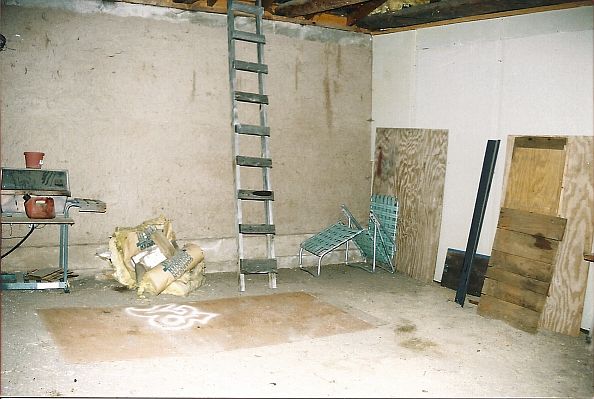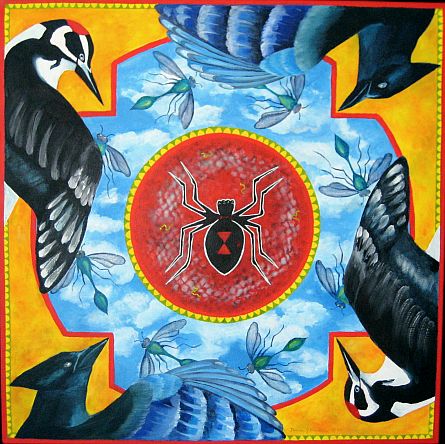This article was originally written by Donna Caulton in July 2012 and posted on Jeane Weigel's artist blog: blog:
http://www.highroadartist.com
There
are so many ways to describe the pathway to calling oneself an artist
and to permitting that artist inside to develop and sustain a vision.
The stories that come to the forefront of memory differ from one day to
the next. They can flow from childhood, through experiences of and with
family, from educational experiences, from travels. There are so many
ways of organizing remembrances.
Lately some vignettes of my own
journey have come to mind that seem like seminal moments in my artistic
development. These do not begin in childhood or in my school years, but
at a time in life when many things were in flux, and changes came fast. I
was 36 years old, recently divorced and in the process of sending my
two amazing kids off to live with their dad for a couple of years. This
act was excruciating, but the art life that unfolded in the years
thereafter was rich and formative.
Between the time that I
graduated with an art degree from Evergreen State College in Olympia,
Washington, until I moved to Seattle three months later, for reasons I
still can’t fathom, I took a class in Trigonometry at a local community
college. I was three weeks into the course when, Jake, the instructor,
began a discourse about the concept of the “number one.” While he
presented his ideas from a mathematical standpoint, I went off into a
different realm.
I considered all the children of the world, of
all languages, all races, all philosophies, each one learning this very
same concept; that of understanding the meaning of one: the basis of
mathematics, the basis of self perception, the basis of separation from
others, the understanding of one God, and on and on. It occurred to me
that each person must perceive the same concept but through monumental
life differences from person to person. What could be a more unifying
possibility? What could illustrate more clearly that we are all one at
some deep level?
This notion went to the core of my being and
unraveled a deep acceptance of my own world view. The artist in me was
off and running. I never returned to my trigonometry class, but shortly
after settling into a little hobbit-house upstairs apartment in Seattle,
I painted a large four foot square watercolor that I called “Song to
the Number One,” with all the ramifications of its meaning. Many of the
symbols from that painting still appear in my work today, more than
thirty years later.
After
six months of painting large pieces in a very tiny space, I embarked on
the adventure of building my own art studio. Two friends and I leased a
half bay in a downtown Seattle (Pioneer Square) warehouse for next to
nothing, and proceeded to put up walls, a task we really knew nothing
about. A year later, both my friends had moved out and I found myself
holding the lease on the space for the next nine years, where eventually
we had seven studios filled with serious working artists. We were in
heaven.
The neighborhood had a frame shop that helped us all out, a
plethora of restaurants, the Elliott Bay bookstore with a café and
artist’s hang-out downstairs, and about 40 artists in several different
studio buildings, all of whom knew and supported one another and played
together too. We had art shows in places like the funky OK Hotel on
Western Ave, in all kinds of studios and hallways, theaters, and the
bookstore. Neighborhood musicians were playing from warehouses to blues
clubs. It was a fabulous time for us all, and it lasted until
gentrification began in the 1990’s.

I
was painting large scale watercolors at the time, one of which is on
the left in the above photo, a piece called “Lunar Lock,” which won a
painting award at the Bellevue Arts and Crafts Fair and now resides in a
corporate office in Redmond, Washington. Thirty years later, my son was
looking at my website and told me he really liked the DNA painting.
“Huh?” I said, “I never painted a DNA painting.” But, after he pointed
it out, I have to admit it does look like DNA, although that wasn’t my
intent at the time. Now the image is showing up again in the development
of a new project I’m working on with three other artists called,
Creation/Migration: Stories of the Journey.
A few years later I
embarked on the big journey of my life—a four month long trip to South
America to visit the Andes and the Inca Ruins. This journey fixed the
direction of my imagery for all time. In fact it solidified the way I
symbolize ideas in my artwork.
I stayed in Peru for two months, in
Bolivia for two weeks, and in Ecuador for the remainder of the time.
Already heavily under the influence of the cultural Hispanic and Native
American arts of the American Southwest, I was astonished to find so
much similarity in artistic expression in South America. A similar
repetition of shapes and symbols was evident in the paintings on
pottery, the building methods, the walkways, the circular ceremonial
structures, the woven fabrics and the patterns reflecting the daily
lives of the artisans who incorporated them into their crafts. All this
was accentuated by the clarity of color and sky in the clear, high
mountain air.
After returning to my Pioneer Square studio, the
first painting I painted was called Puka Pukara, named after a ruin in
the hills outside of Cuzco, Peru. The pink coloring of those rocks is
reflected in the painting, but the symbols are a composite of other
experiences along the journey’s pathway.

With
this piece I began laminating different types of paper together,
creating varied textual surfaces. I also imbedded fibers in and on top
of the work, and started stitching brilliant little discs to the
surfaces. The circle and square became a permanent part of my visual
language, representing balancing forces, the matrix and the grounding of
the amorphous and ethereal aspects of the work. I also became
consistent in using a center focus and seasonal and lunar cycles to
speak of renewal, centering and balance of opposites. For many years I
utilized this same set of elements in my large watercolor paintings and
gradually the language gave my work its signature. I found, in using
these elements, a perfect voice for expressing my personal interests in
cultural history and in the cycles of the life forms of the planet.
In
the late 1980s, while I was working as an Artist-in Residence for
Washington State, I taught watercolor classes in the state prisons.
There I gained the dubious distinction of being the first woman to teach
an art class in the maximum security unit of Walla Walla State
Penitentiary. I never liked to paint in front of anyone else, even as a
teacher, so I rarely did demos. Mainly, I wanted students to develop
their own styles, and not try to copy mine. Plus I need total focus when
working on a piece, and teaching a class interferes with that focus.
But once, while working in Twin Rivers Correction Center, the students
asked, over and over again, if I would paint in class. So I laminated
several different kinds of papers together and then started layering in
the colors. The piece gained its meaning from the circumstance. I called
it “Unlocked” and gave it the essence of brilliant light escaping its
boundaries. You see, I didn’t like being locked in any better than the
prisoners did!

Of
course there were many stops along the roadway to New Mexico, but the
trip to South America and the artwork that was generated by that
experience set me on a pathway to New Mexico. It was not until twenty
years later and a full lifetime of experiences, however, that I actually
made that leap.
In 2004 I began making extended trips to the
mountains of northern New Mexico. My travels to the region had an
immediate effect on my art. I recognized, right away, that the brilliant
light of the area required a change in how I used color. After having
worked with watercolors for 20 years, I switched to acrylics because I
wanted the immediacy and vibrancy they offered.
The High Road Art Tour, which I experienced twice as a visitor, heavily influenced my decision
about where to live when I made the move to New Mexico. I found the
quality of art along the tour route to be far superior to that of other
tours, and the longevity of High Road Artisans, the non profit
organization that puts on the tour, to be encouraging and impressive. In
addition, the high mountain valleys, each with its own village, were
beautiful, quiet and inviting, with clean air and multicultural
traditions.
I found a charming old adobe house to my liking in the
village of Chamisal, right in the heart of what used to be the old
plaza. The tiny Catholic church that appears on the New Mexico state
stamp is right across the street from my house. Many of my neighbors are
in their late 80s and 90s, and it is said that their longevity is due
to the good clean mountain water we all drink. It is a good life in
Chamisal.
My studio, when I bought the place 5 years ago, was a dirt floor garage with heavy 2×4 and plywood swing-out barn style doors.
Little
by little I added a plywood floor, a long closet, and sheet-rock walls
on the long walls, leaving the two shorter walls exposed brown adobe
mud. I got some nice long windows and French doors from the Habitat for
Humanity Restore and replaced the ugly old heavy doors. Eventually I put
in some insulation foam between the vigas in the overhead and voila!
For a few thousand dollars spent over a period of four years, I had a
lovely work space and still retained a 24′x 9′ dirt-floored storage/work
area in the rear. Given that my lovely old house has only one bedroom,
this studio space is a blessing and provides an excellent viewing space
for my work during the studio tour in September.




One
of the nice things about all this New Mexico sunshine is the easy
accessibility for exposing the photo-sensitive etching plates I use to
make prints. I have a press and make small editions of solar etchings
with this lovely nontoxic method. The plate is exposed by light and
developed in water. What could be more perfect for New Mexico, where
there is enough sun all year long to use this method?
Because
my focus has never deviated from the notion of planetary balance, many
of my paintings can be described as mandalas of the natural order. In
these pieces I capture the story of interdependence between the plants
and animals of my region. These mandalas have been my focus for the past
several years. Here are some examples:
The
natural world and love of the land have always been grounding forces
for me. As my love of New Mexico and my relationship to the land grow, I
see a circle of wholeness to the story of my journey. The symbols and
meaning in my work have remained the same from the beginning. The tools
and visual expression have changed somewhat over time. By this time in
my life I feel the art and I are not separate. I rarely speak of meaning
in my work now, because its evolution has become the language of
expression for me. The rest is up to the viewer.













































